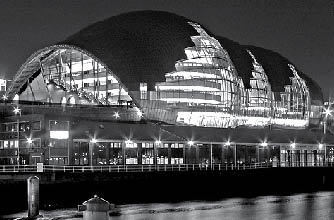Product Follows Process: Atelier '07
by Albert Chao

Atelier: a workshop or studio, especially of an artist, artisan, or designer.
The annual Atelier ’07 will take place throughout the architecture studios in UB’s Crosby Hall on Main Street the week of March 26. Work will displayed in impromptu fashion. Unfinished models and drawings will be on display in halls and studios. Undoubtedly, anyone walking through will also see coffee cups, food from vending machines and students fastidiously working out models and ideas over their desks.
Atelier is important because it emphasizes process rather than product. Typically, people experience architecture—a building, a renovation project, or even a new design of a coffee cup—in its final stage. However, design includes many steps; in many cases, the process of design is as important as the final product. During Atelier, instead of looking at a building, you look at models. Instead of looking at form, you look at ideas. These processes of development are crucial and are often where most of the exciting work takes place.
During Atelier, professors, students and others are also exposed to the work of peers. This is a chance to “take a step back,” look at other interests and ideas and undoubtedly re-examine one’s own work. It is also a moment where others can critique, exchange ideas and be exposed to other modes of thinking. In a contemporary society of interconnected media, a physical engagement of models and forms can still be important in the development of ideas.
This collective attitude—showing process work, sharing of ideas and interactive discourse—parallels the lectures of architects and scholars who have been invited to speak at UB. This will be highlighted during Atelier, where three internationally renowned architectural practices, each with distinct and unique methodologies, will present their ideas.
On Tuesday, March 27, Spencer de Grey, a founding principal of Foster + Parters, a firm in London, will be coming to speak. Upon finishing his studies at Cambridge University, de Grey pursued development in education and began working on one the first middle schools in the UK for the London Borough of Merton. He continued this work when he joined Foster Associates with the Palmerston Special School in Liverpool.
Since, de Grey has worked with a number of cultural institutions, including the Sage Music Center in Gateshead, England that was completed in 2004. This project balances both the future and the past. The futuristic skin of the building was made possible by advanced computer and digital technology. However, this aspect is balanced by molding the main concert hall after a superb acoustic model, the late 19th-century Musikverein in Vienna. De Grey is currently working on the Boston Museum of Fine Arts.
Peter Eisenman, coming as the Birdair lecturer on Wednesday, March 28, will share other interesting aspects of his architectural practice. He was one of the leaders against Modernism in architecture, a movement that includes Frank Lloyd Wright, Le Corbusier and Mies van der Rohe. Modernism embodied, amongst other principles, the phrase “form follows function.” This ideology reduced different rooms into plain boxes: A bedroom might be the same as a living room.
As a part of the Deconstructivist movement, Eisenman challenged this idea and emphasized form rather than function. He expressed these ideas in his winning design of the Wexner Center, completed in 1989, with fragmented geometric forms that create a disorienting experience. In addition to being complicated, it has since also suffered damage, ironically, due to initial inadequate functional details of the building. Nevertheless, the building has since been renovated and still resonates the intellectual challenge to Modernism.
Eisenman is also the architect for the Holocaust Memorial in Berlin, the cultural complex in Santiago de Compostela, Spain, and the recently completed Cardinal’s Stadium in Arizona.
Tod Williams and Billie Tsien, as 2007 Martell Distinguished Visiting Critics, will have a different impact on the students. Throughout the week, they will work and engage with graduate students as well as present a public lecture on Friday, March 30. Their approach to architecture is subtle, yet powerful. Amongst their award-winning buildings, their design of the American Folk Art Museum in New York City, completed in 2001, creates what they describe as a “house” rather than a museum for folk art. A skylight filters natural light through to the galleries. Circulation through the eight floors is provided by a central dynamic concrete staircase. Smaller staircases also create a more intimate circulation. The building’s façade is created by 63 panels of Tombasil, a white bronze alloy that has never before been used architecturally. The image evoked is of an abstracted hand that catches and reflects the light of the morning and evening sun.
A book of Williams and Tsien’s work will be published by buffaloBOOKS in the fall. The Martell Distinguished Visiting Critic Program is supported generously by Christopher and Sally Martell. Christopher Martell graduated from both undergraduate and graduate architecture program at UB. He has worked locally with Kideney Architects and also collaborated with Cannon Design. He worked as a lighting designer with Frost Lighting, Inc. in New York City before setting up Key Lighting & Visual LLC, a lighting production company.
Upcoming:
On Saturday, March 31, Frank Fantauzzi—architect, artist and professor—will open his live-work space in an old industrial factory at 1716 Main Street to host two University at Buffalo MFA artists, Penelope Stewart and Elinor Whidden, in their thesis exhibition. For the duration of the exhibition, the space will be named Gallery 1716. More information in next week’s Design Matters.
Design Matters is presented in association with the UB School of Architecture and Planning and supported by a fellowship endowed by Polis Realty.
|
Issue Navigation> Issue Index > v6n12: One Piano, Four Hands (3/22/07) > Product Follows Process: Atelier '07 This Week's Issue • Artvoice Daily • Artvoice TV • Events Calendar • Classifieds |









 Current Issue
Current Issue